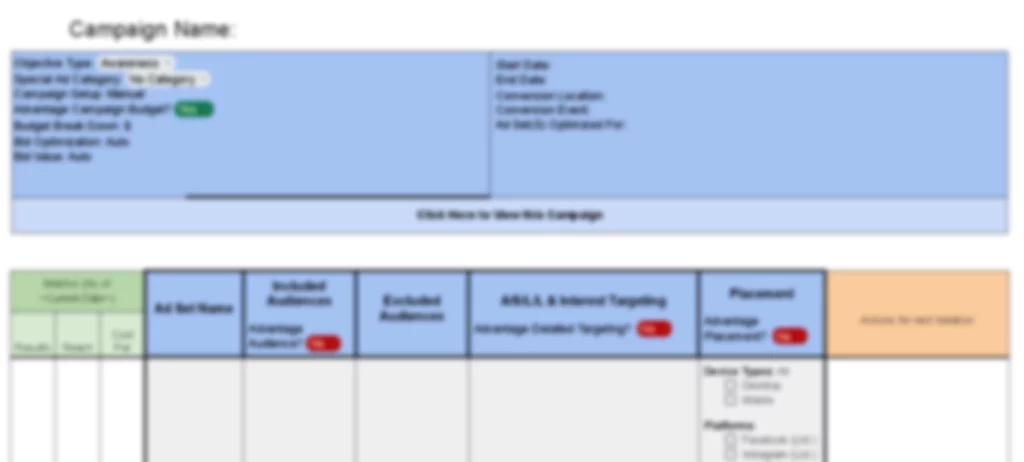“What is the cost of Facebook advertising for this campaign?”
“What about Google PPC ads?”
“What if we want to use [INSERT RANDOM AD PLATFORM]?”
We get these questions all the time whenever a client is considering our advertising services. Fortunately, the authentic answer has a few parts, and figuring it out is pretty simple. While our service costs can be estimated using the handy dandy calculator below, the service fee that we (or any other advertising agency) would charge is only part of the overall equation.
Luckily, the math is usually simple addition and multiplication when it comes to the cost of advertising.
In this post, we break down the true costs associated with advertising on Facebook or any other platform.
Your Cost Of Advertising = Production + Service + Ad Budget
Any time you want to advertise, regardless of the platform, the campaign can be broken down into three parts:
- Objective – WHY are you advertising in the first place and what ad auction(s) will you be entering?
- Audience – WHO are you going to be your target(s) for this campaign?
- Creative – WHAT visual(s) are going to be used along with the messaging?
This OAC framework is universal to advertising. However, that framework only deals with the ad budget itself. The costs to produce the necessary assets and get the campaign launched are hidden behind-the-scenes. Which is the main reason we wanted to publish this blog post: the genuine costs of getting an ad campaign out the door can quickly add up if you aren’t careful.
Production Costs Can Be A Silent Killer
As you’ll see below, advertising budgets themselves are pretty straightforward. Getting to the point where those budgets are being spent can be a huge hidden cost of advertising if you aren’t careful.
There are two main types of production costs associated with an advertising campaign: asset generation & operational setup.
Asset generation deals with the costs to produce the raw images and videos that will be used in your Creatives. If you already have visuals you can pull off the shelf, that will save you production costs. Even if all you need to do is some cropping or light editing, that will cost far less than generating new visuals from scratch.
Producing images or videos from nothing that will be used in an advertising campaign typically involves a professional designer and/or videographer. Sometimes even a team of people. A video has even more moving parts to produce. The script, raw recording, editing, and even post-production are all costs that can add up. When doing videos specifically for an advertising campaign, the Objective needs to be abundantly clear. Otherwise, you risk going through a ton of effort to produce a video asset that doesn’t work for what you are trying to do.
For videos, we recommend making them platform-agnostic and re-usable. If a video works in one place, say Facebook, there is a good chance it might work elsewhere like YouTube or TikTok. Don’t digitally “paint yourself into a corner” by producing a video that can ONLY be used on one platform. If you must make something that is platform-specific for some reason, minimize that dependency. Make sure the production files are easy to modify and re-export for each platform. Or make sure it is easy to edit out and replace the platform-specific bits.
You would also be wise to make images platform agnostic and re-usable too. Fortunately, those are usually much easier to edit after the fact. Especially if you have the production files 😉
Operational setup deals with the digital tracking under the hood required to report on the ads accurately. This typically looks like installing the platform’s tracking pixel (sometimes called the “tag”) and firing the appropriate conversion event(s). For example, if you are running traffic to a lead magnet landing page with Facebook ads, not only do you need the Facebook pixel on your site, but you also need to configure the Lead conversion event when someone clicks through your ad AND also opts in for your lead magnet. Without this operational foundation, you are paying to run ads into a black hole with no formal reporting available in the ad platform. That is NOT pro!
Installing pixels to your website and firing conversion events requires specific skill sets outside of ad loading. This is arguably the most technical and critical-to-get-right part of advertising because if you do it wrong, you can be reporting on incorrect data. Even advertising agencies have a few specialists on their team for this technical work. At Be Pro, we recommend Google Tag Manager because this free tool only needs to be installed once on your website. Plus, you can modify all digital tracking directly from the tool without bothering your webmaster. (We recommend watching this presentation from our founder Paul Sokol for more insight into HOW to use Google Tag Manager for conversion tracking.)
Service Costs Are A Real Thing
Ok. You have invested a bunch of money to script, shoot, edit, and export a video asset that can be used for an advertisement.
Guess what? Every person involved in the process up to this point likely has zero idea HOW to actually get that video asset running as an advertisement. The skillset to get a video file uploaded into some ad platform and then running it to a certain audience for a particular reason is completely separate from the generation of the video file itself.
This is where service costs come into play.
Every agency is different in how they price their service offerings.
At Be Pro, we try to make it very simple. There is a flat cost for the advertising Plan, which assumes you have the video or image asset(s) ready to upload. And then, there is a fair cost for every individual ad that needs to be loaded into the particular platform. Harkening back to the OAC framework, if you have 3 Audiences you want to target, with 3 different Creative setups, that means there are 9 ads in total.
And yes, you can use the same video asset across multiple Creative setups. For example, you might have 3 different headline & text combinations for a particular advertising platform that use the same video asset. This notion feeds back into the whole production cost part of the equation. You HAVE to get the video and/or image right from the get-go to maximize its usage in an advertising campaign.
Look at it from a consumer standpoint: how many times have you seen the same video from some big brand being used across different advertising platforms? They invested the resources and effort to get the visual correct so it could be reused in many places.
To keep things fair, here at Be Pro, one Ad Plan can consider up to FIVE Objectives; five OACS. This affords things like doing traffic & remarketing along with a Top-of-Funnel initiative.
Your Ad Budget Determines Overall Reach
When running an ad campaign on Facebook, Google, or any digital platform, one of the key distinctions is your budget. This can either be a lifetime budget for the campaign run or a daily budget as long as the campaign is running. If you think about old-school direct mail, this is the equivalent of how many pieces of mail you are sending. If you send 100 mail pieces, that will have less of an impact than if you send a thousand pieces of the same mailing.
The difference between direct mail and online advertising platforms is the auction concept. With direct mail, you are sending X pieces of mail to X addresses. That comes with a direct postage cost.
With online advertising, you are bidding against other advertisers for the right to show your ad to your target audience. That is why most online advertising platforms have a Cost Per thousand impressions (CPM) data point. This is how much you are spending, on average, to reach 1,000 people; “milli” is the prefix for thousand hence Cost-per-Milli where CPM comes from.
When calculating your advertising budget, you generally want to think about it in daily costs. In other words, how much per day are you willing to spend to reach people? How much per month are you willing to spend which is 30 days of advertising?
This is where the rubber meets the road for your ads. Given all the production costs, and all the service costs, combined with how much you are willing to auction per day, what results (Objective) are you gambling to achieve per day?
For example, let’s say you are spending $20/day on Facebook to drive a Leads Objective. From the platform perspective alone, you might be able to generate a Lead for $1, which means that on a given day you are generating 20 Leads. And, to keep the math simple, let’s pretend 1 of those 20 Leads turns into a $100 sale.
Now, if the video costs you $1,000 to produce and then there is a $500 service fee from the agency you are using, that is an automatic $1,500 investment for your advertising campaign before the ads even go live. You would need to run ads for 15 days to break even on the production and service costs before you start making money as a business; $100 in sales per day over 15 days.
However that also means you have spent $300 in ad budget (15 days x $20) to get to that point. Which means technically you need to spend $1,800 before you can start turning a profit. This is also assuming you consistently generate 20 leads per day, and 1 of those leads consistently turns into a $100 sale.
If this is confusing to you at this point, you are not alone. Advertising is not an exact science. Advertising is an art that can be approached scientifically. And at the end of the day, you are gambling that:
- For the Objective YOU want.
- Targeting the Audience YOU choose.
- Showing the Creative YOU have produced.
That YOU will get the results your business needs.
To try and make this advertising choice easier for you, please use the advertising calculator below. This calculator factors our raw Plan costs, plus the number of Audience/Creative combinations, blended with your daily ad spend.
This is only factoring in ONE Objective. If you have multiple OACs to consider, your costs will be expanded because each Objective has its own budget, Audience(s), and Creatives.
At the end of the day, the better you are able to Plan your advertising, the better your results should be. You should Plan your ad campaign even before you start investing in production costs! How else would you know what creative asset(s) you need to produce?
Free Resource – Download Our Ad Planning Tool
Whenever we Plan an advertising campaign, we follow our advice!
We developed an ad planning tool to ensure that there is one source of truth for the Objective(s), Audience(s), and Creative(s).
You can also use this tool to audit your existing Meta campaigns by documenting what is so in the ad platform. Then, you can use that audit to improve your advertising results.

👇 Get The Ready-To-Use Planning Template Below 👇
